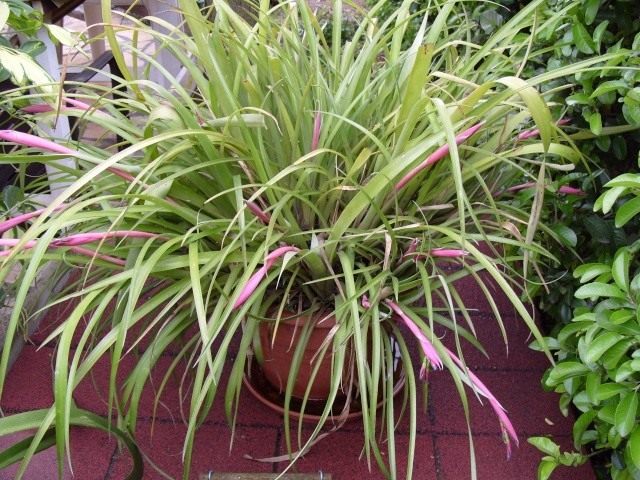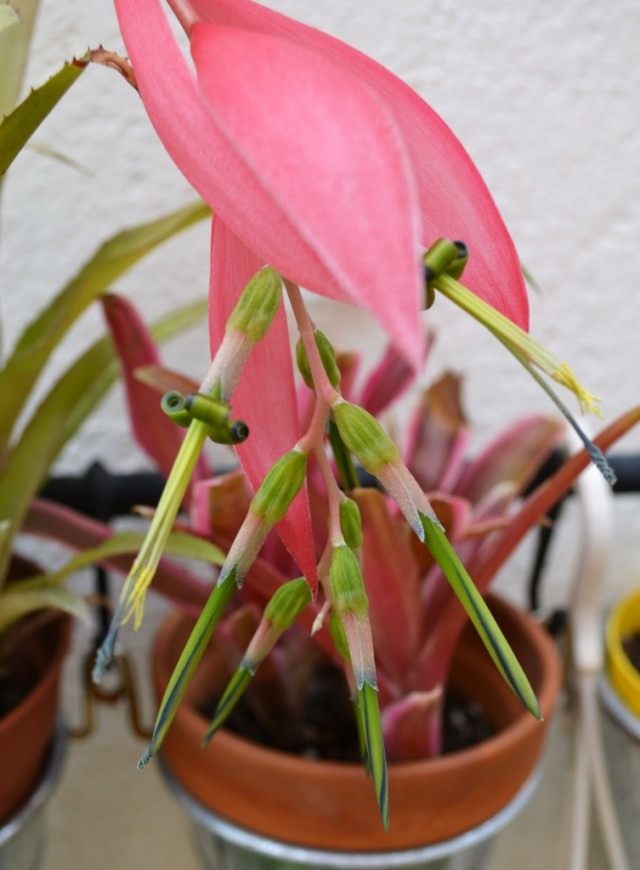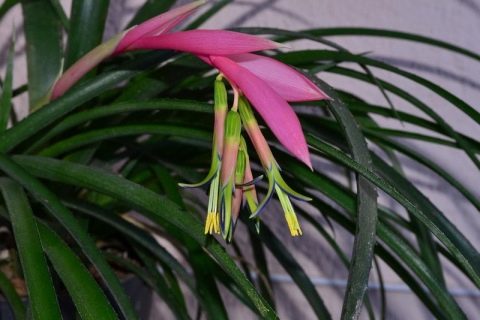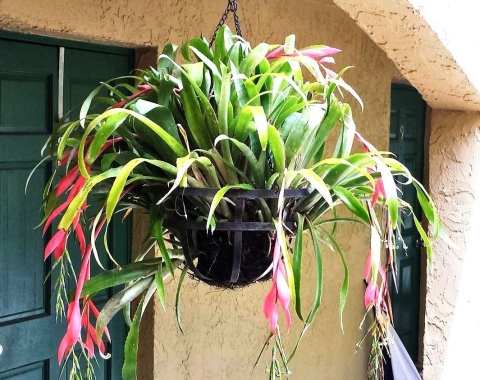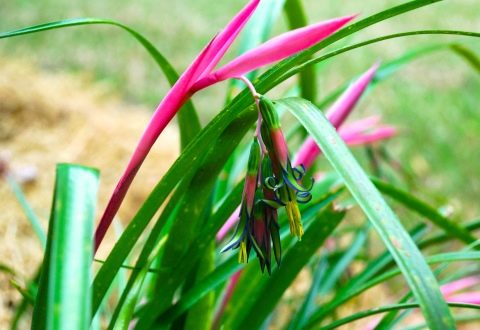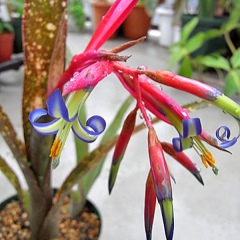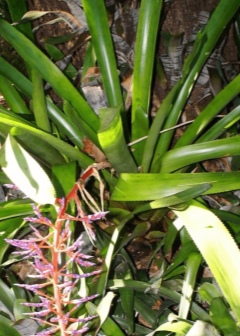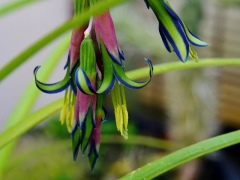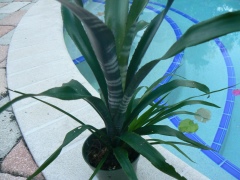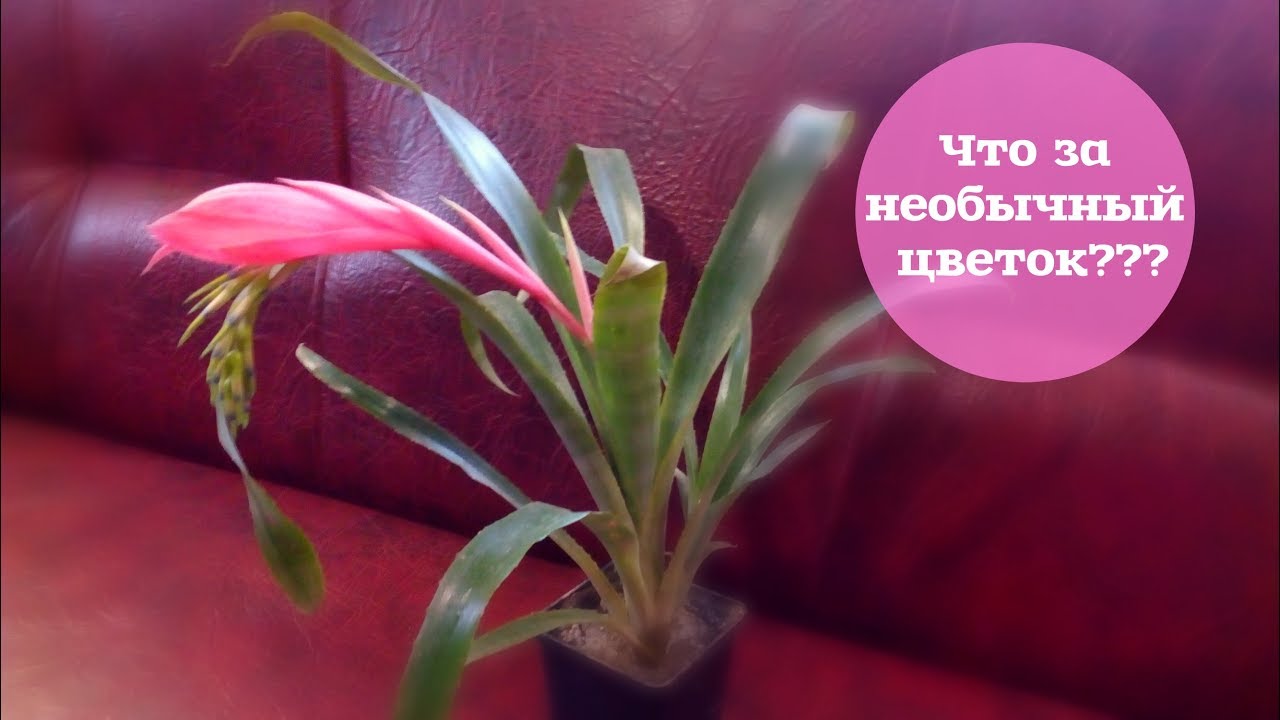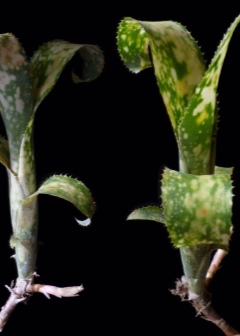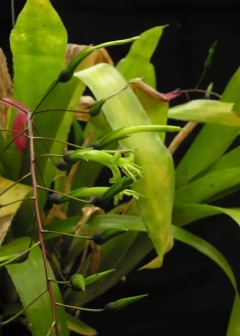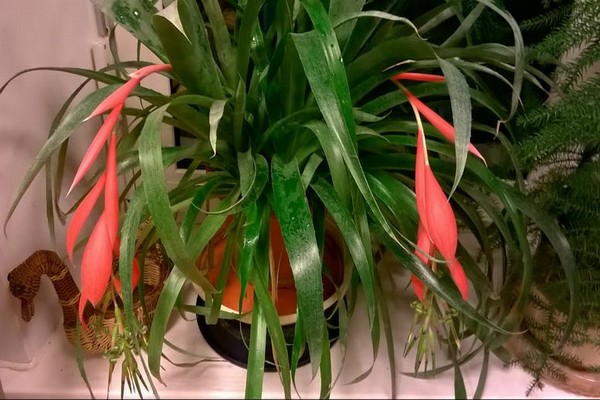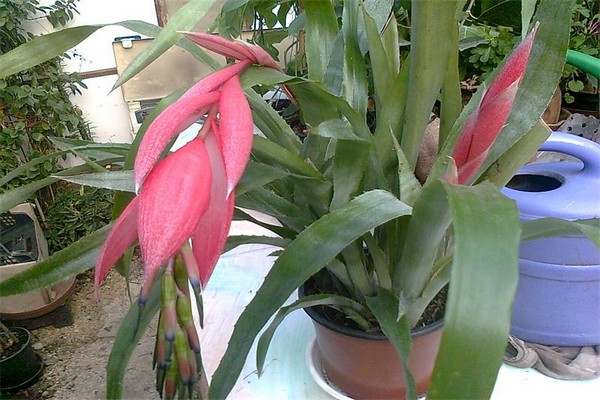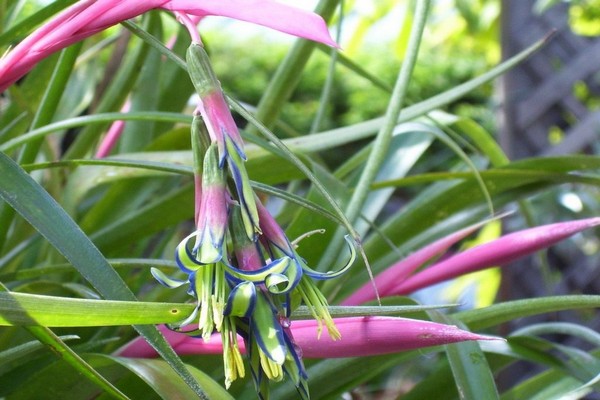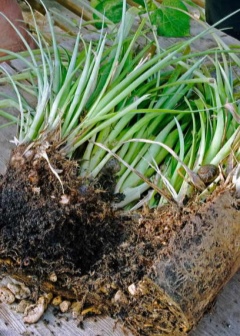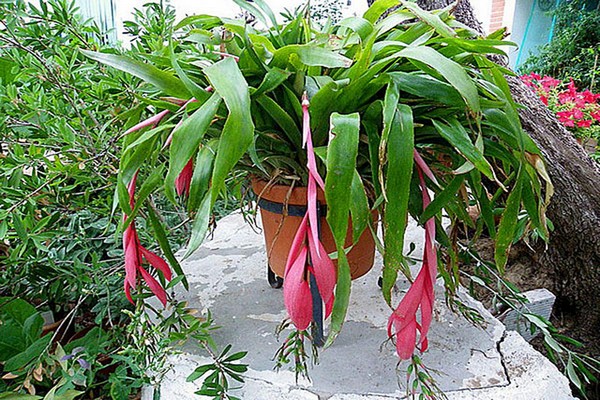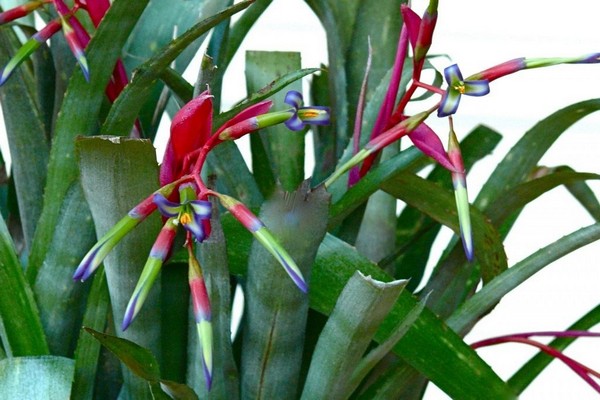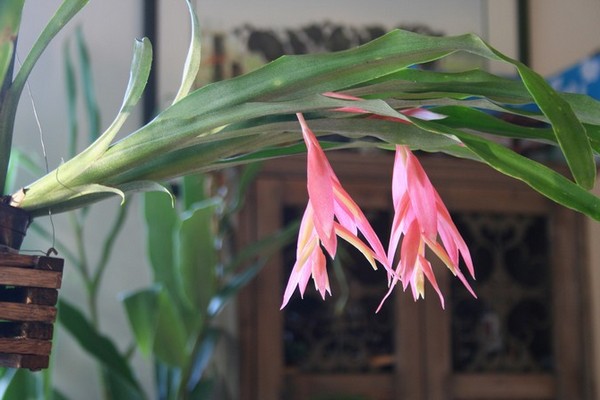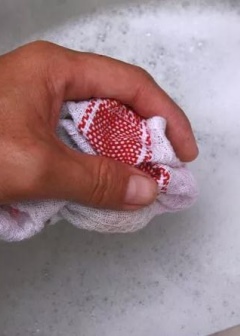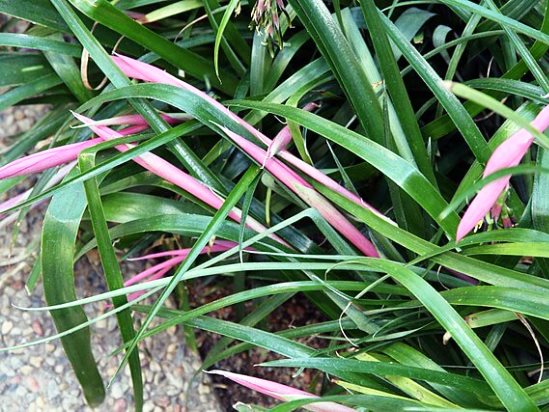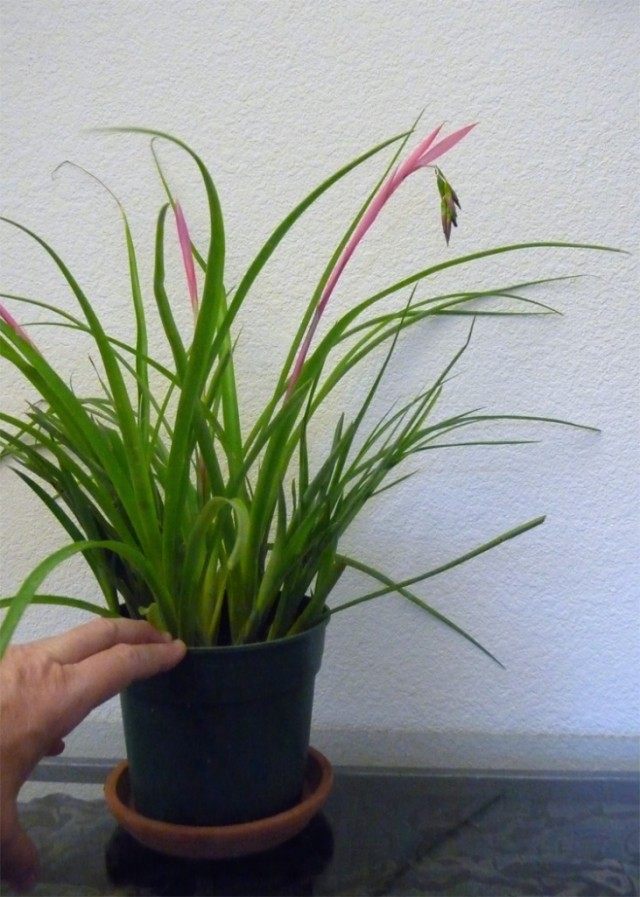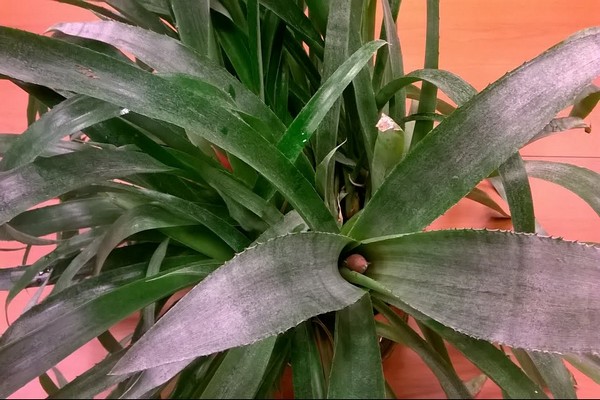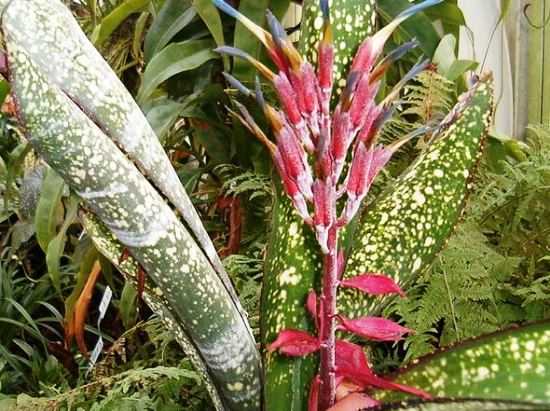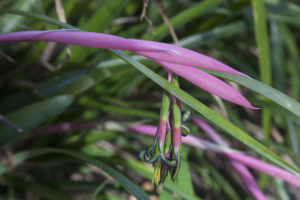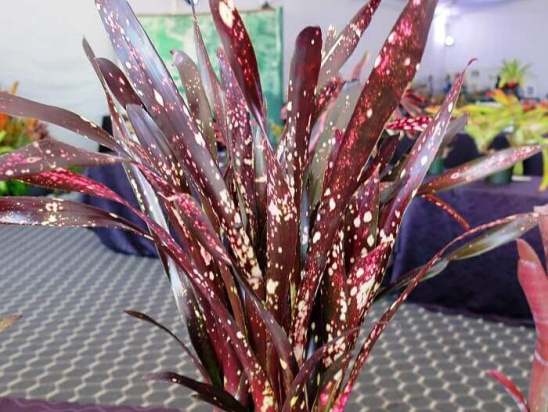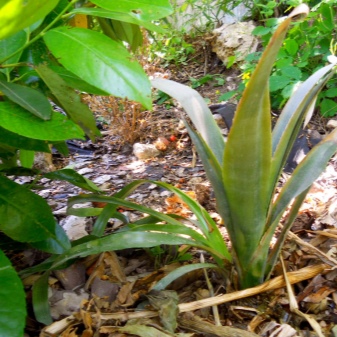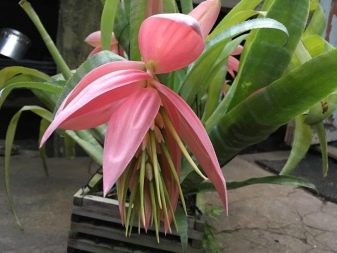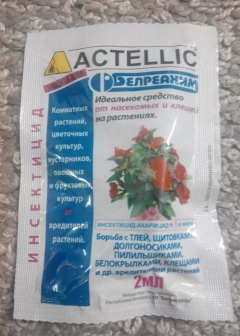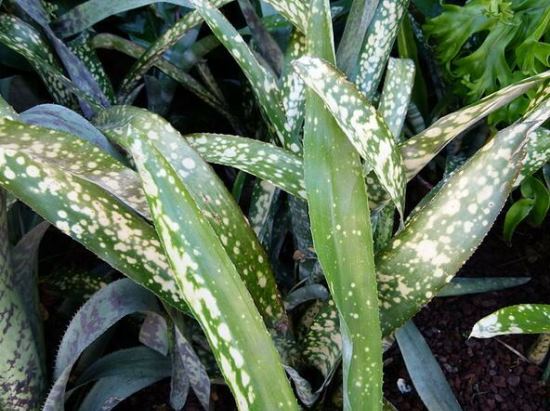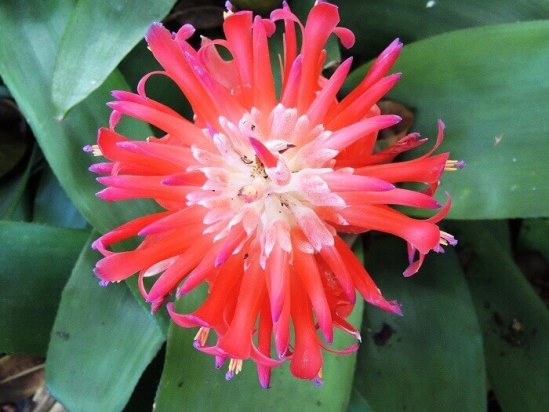Bilbergia - plant care and maintenance
Bilbergia are unpretentious and much easier to tolerate drafts and dry air than other indoor plants. Bilbergia care and maintenance involves placing the plant in a shaded or bright place, but not under the influence of sunlight.
In spring and summer, the substrate should be constantly moist, but not waterlogged. In winter, it is enough to water once a week, allowing the earthen coma to dry out slightly. For irrigation, you need to use only soft and settled water at room temperature. You can water by pouring water into the funnel of the leaves of a plant with a dense outlet, and at temperatures below + 20 ° C and after flowering, you need to moisten the substrate.
The optimum temperature for keeping in the spring-summer period is +24 + 28 ° С. In autumn, it is necessary to smoothly lower the temperature to + 18 + 20 ° C. In the period from October to February variegated forms must be kept at + 16 + 18 ° C, and forms with green leaves + 14 + 16 ° C and always in a bright room. Keeping at temperatures in winter below +10 +12 ° С will lead to disease or death of the plant.
Transplantation is carried out annually after the flowering period into a substrate of leaf, humus, sod, peat soil and river sand (1: 1: 1: 1: 0.5).
Bilbergia, when grown, is disease resistant with proper care and maintenance. Can be damaged by pests: spider mites, aphids, scale insects and mealybugs. Control measures: remove pests with a sponge with a soapy solution, and in case of severe damage, it is necessary to treat with karbofos or actellik, a solution of 15-20 drops per 1 liter of water.
What difficulties can there be with bilbergia?
The plant will grow healthy and bloom profusely if you follow the rules of caring for it. It is worth taking it out in direct sunlight, and the shoots will get burned. They appear as brown or rusty spots.
If the plant is watered a lot, it can also die. Basal rot develops, shoots rot. When you are about to replant a plant, be mindful of the ground. The soil for planting is prepared either according to the recipes written above or bought in the store.
Taking care of the plant is easy. If you go away for a week on business, and there is no one to look after the flowers, during this time the shrub will not die. Bilbergia tolerates a little dry air and a temporary lack of water, but put the container with it in a bowl with wet grass or moss. Bilbergia generally perfectly adapts to the domestic climate, rarely gets sick and will beautifully complement your interior design.
Description
Bilbergia is native to the subtropics of South and Central America. In its natural environment, it can also be found in Argentina, Mexico, Brazil and Bolivia, where it lives on tree trunks. In this regard, the root system of the plant is not large - it uses it only for fastening, and receives nutrients and water through the leaves.
In indoor conditions, the flower usually grows up to 45-50 cm.Its belonging to the Bromeliad family is not easy to determine. The similarity can be traced only in the funnels of the leaves and their dense texture.
The leaf plates are long (up to 40 cm) narrow and have a pointed tip, therefore, they look like cereal or bulbous ones. Their surface is completely covered with small scales, and the edges are provided with thorns or denticles.
Depending on the type of flower, the leaves can be solid dark green or variegated. There are also varieties covered with a gray waxy bloom, designed to protect the plant from excessive moisture evaporation.
Inflorescences appear twice a year - in spring and autumn - and remain on the plant for 3-4 months. They are drooping panicles (spikelets) that form on long peduncles growing from the center of the rosette of leaves.
The buds are small and arranged in a spiral. Their petals can be painted in a wide variety of shades: from pinkish purple to yellowish green. At the same time, deep pink or red bracts give additional brightness to the spikelets.
Bilbergia blooms at the age of 2-3 years, and after the completion of this process, the rosette from which the peduncle came out dies. However, before that, she manages to release a large number of side shoots, giving rise to new plants.
Where to plant bilbergia?
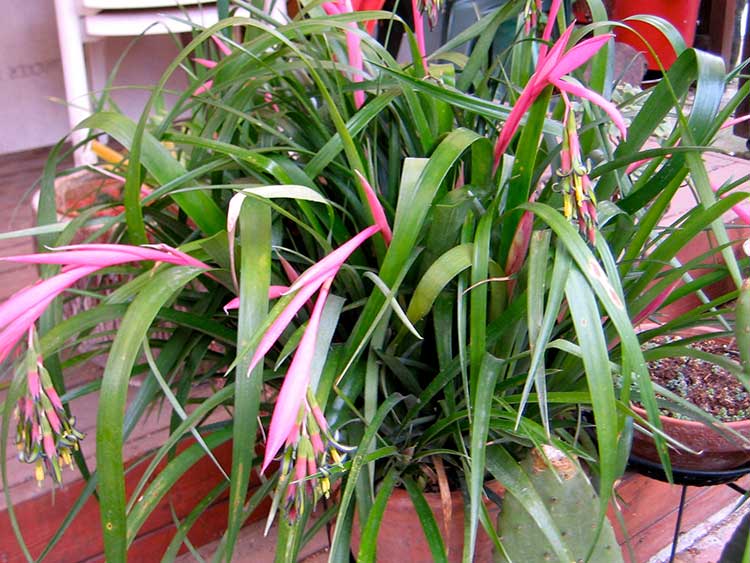 Bilbergia drooping is best planted in a planter so that the rosettes hang freely.
Bilbergia drooping is best planted in a planter so that the rosettes hang freely.
Like other tropical plants, bilbergia is demanding on the soil. The soil in the pot should be loose, peaty-leafy, with the addition of moss fibers and coarse river sand.
The pot for bilbergia should be medium in size: too large and too small containers are contraindicated. The fact is that the plant must have time to "drink" the water before it sour in the soil. The soil should have time to dry out between waterings.
The recommended pot size for an adult plant is 25-30 cm. For easier transplanting, choose pots with a top diameter 3-5 cm larger than the bottom diameter.
A mixture of high-moor peat, leafy soil, moss and humus should have a pH of 5.0-5.3. The optimal pH value is a guarantee of successful cultivation of Bilbergia. Both acidic and alkaline soils are contraindicated in all bromeliads.
If it is not possible to make the mixture yourself, it is recommended to buy a soil mixture for orchids or aroid plants.
Types and varieties of bilbergia
Most often, the following types of bilbergia are grown in room culture:
Bilbergia drooping (Billbergia nutans)
Or "Queen's tears" - a plant that reaches a height of 35-40 cm and forms a rosette of leaves with a drooping flower arrow up to 80 cm high. The inflorescence consists of greenish-purple flowers and bright pink bracts.
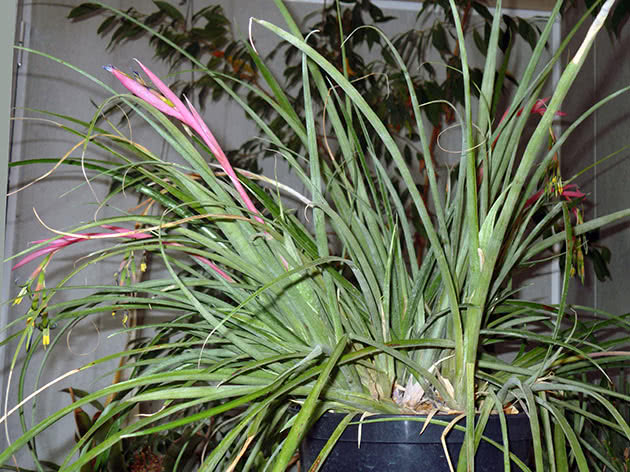 In the photo: Billbergia nutans
In the photo: Billbergia nutans
Bilbergia magnifica
This is a plant from the southeastern regions of Brazil, forming a rare elongated rosette of large, rigid, narrow, prickly leaves up to 70 cm long and about 8 cm wide with a pointed apex. The leaves are colored gray-green and covered with transverse light stripes. The drooping peduncle of this species, about 30 cm high, bears a fleshy inflorescence up to 30 cm long from flowers with spiral-shaped blue petals covered with large pink bracts.
Bilbergia tape (Billbergia vittata)
It differs from other species in variegated leaf color in different variations from olive to bronze. On the underside, the leaves are covered with silvery stripes. The flowers of this species are painted in bright blue, and the bracts are pink.
 In the photo: Bilbergia tape (Billbergia vittata)
In the photo: Bilbergia tape (Billbergia vittata)
Bilbergia green-flowered (Billbergia viridiflora)
It is a large epiphyte that grows in southern Mexico at the foot of the mountains and near forest rivers. The plant has a dense rosette of dark green leaves with jagged edges. The leaves, like the peduncle, are covered with grayish scales. The flowers consist of green petals up to 5 cm long.
 In the photo: green-flowered Bilbergia (Billbergia viridiflora)
In the photo: green-flowered Bilbergia (Billbergia viridiflora)
Bilbergia zebra (Billbergia zebrina)
A plant with purple-bronze leaves in a large transverse strip. The flowers form a loose raceme with bright pink bracts.
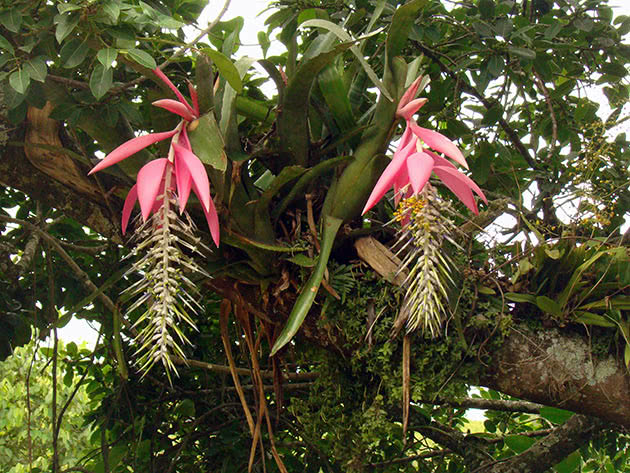 In the photo: Bilbergia zebra (Billbergia zebrina)
In the photo: Bilbergia zebra (Billbergia zebrina)
Bilbergia saundersii
This is a medium-sized epiphytic plant with a narrow rosette of leaves covered with thorns at the edges, painted green with a bronze tint at the top, while below the leaves are red, painted with an intricate pattern of spots, stripes and dots of a pinkish-yellow hue. The flowing peduncle covered with broad-lanceolate leaves bears a yellow-green-blue inflorescence.
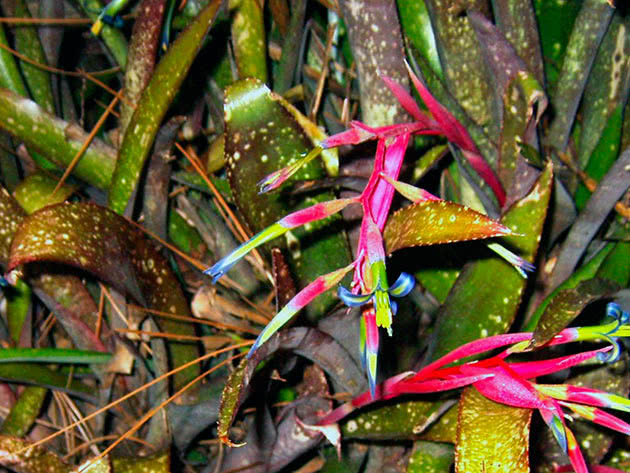 In the photo: Billbergia saundersii
In the photo: Billbergia saundersii
Bilbergia pyramidal (Billbergia pyramidalis)
Comes from the tropics and subtropics of Venezuela, Brazil and the Antilles.Its leaves up to 80 cm long and up to 6 cm wide form a narrow funnel-shaped rosette of broad-linear leaves pointed at the end, and a pyramidal inflorescence up to 15 cm long with small standing pink bracts twisted at the base and pale red flowers covered with light felt pubescence. This species blooms from mid-spring to mid-summer.
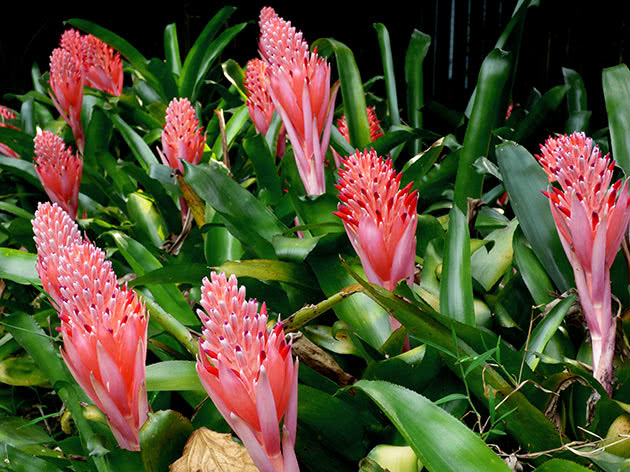 In the photo: Bilbergia pyramidal (Billbergia pyramidalis)
In the photo: Bilbergia pyramidal (Billbergia pyramidalis)
Euonymus - care, photos, species
After this article, they usually read
Add a comment
Description of bilbergia with photo
We offer a description of indoor flowers bilbergia. The flowers range in color from deep purple to almost colorless. They can differ in width and aroma (some have a sugary, pungent smell, while others hardly feel it). According to the shape of the leaves, bilbergia can be divided into two groups - bilbergia with curved foliage and helsodia with petals resembling a coil. We offer you to see indoor flowers bilbergia in the photo: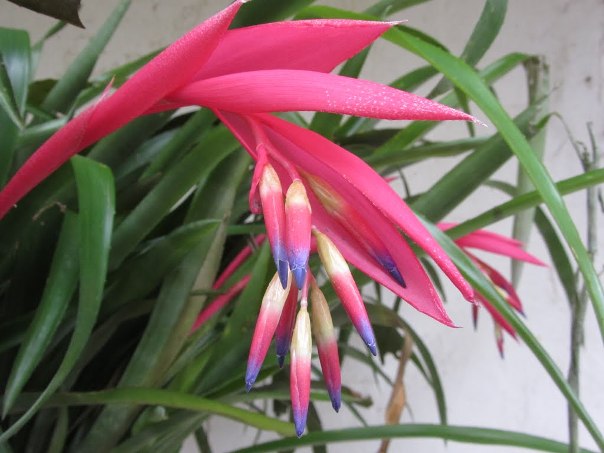
Behind, the leaves are hard with a skin that has a bright color or monochrome color. On the sides, each leaf is covered with small scales, and the leaf itself can have absolutely any shape, for example, among fans of indoor plants, foliage in the shape of a triangle and a narrow line is very popular. The leaves at the inflorescence are large and picturesque in color.
The seeds are stored in hard berries just below the flowers. They calmly sprout in the rocks, but they also feel comfortable in the garden - it is considered one of the most unpretentious indoor plants.
Due to the fact that new shoots always appear around the trunk, bilbergia outwardly resembles a huge, lush shrub. It is made up of several independent outlets up to one meter in length.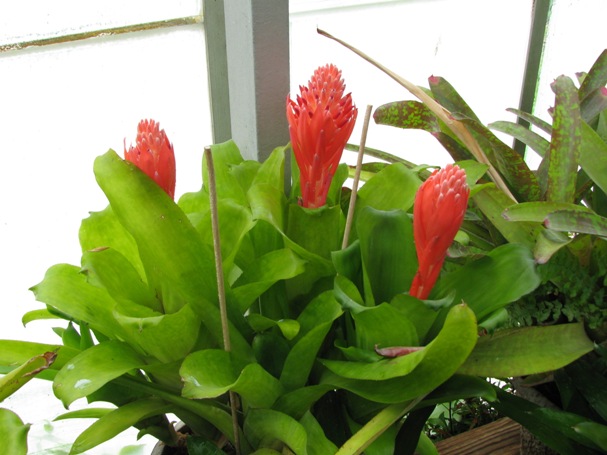
Bilbergia drooping and its photo
It is one of the subspecies of bromeliads. Bilbergia drooping grows in Brazil, Argentina and Uruguay. This flower is most often used as a houseplant, probably one of the most popular flowers of the bromeliad family. They can grow almost anywhere, be it a pot or a garden bed, they have several roots, which are easy enough to fix and they will receive the necessary amount of moisture and nutrients from the air. They tolerate high humidity well, so cups should be filled with water when it rains.
Look at the photo of drooping bilbergia: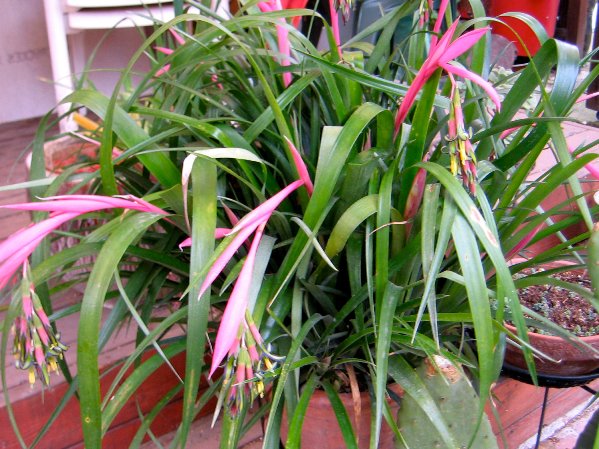
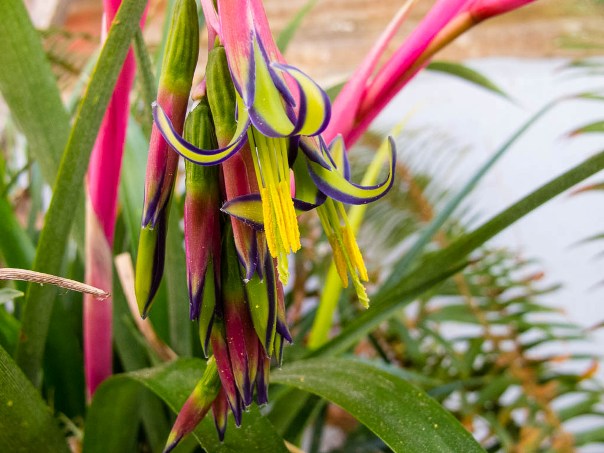
Leaves of a dark green color with small thorns can be no more than one meter long, from below they are most often covered with gray scales (in good light they acquire a bronze or red color). The inflorescence is loose with small branches that bear only a couple of flowers.
In the spring and summer, be sure to feed the plant with a balanced, diluted liquid fertilizer. It's great if it contains bromeliad epiphytes.
Bilbergia is magnificent and her photo
The plant has small, but long leaves up to one meter high of a gray shade with white and light green veins. They are upright and form a tubular rosette. The flowers themselves are collected in a small lowered inflorescence up to 30 centimeters long. Bracts of bright pink color have the shape of a circle or oval, slightly omitted. Blooms exclusively in summer.
Look at the photo of the magnificent bilbergia: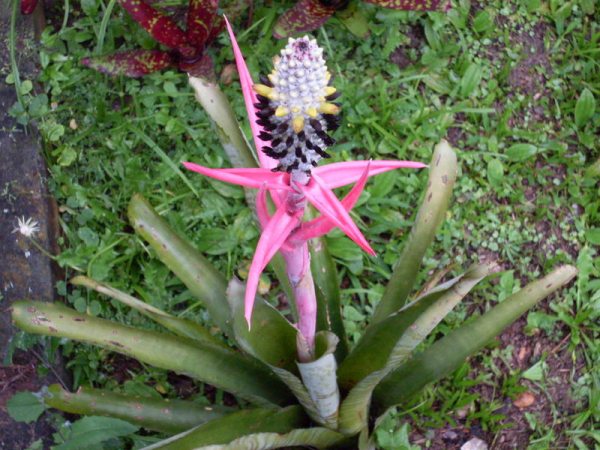
Pests and diseases of Bilbergia
Despite the fact that the plant is resistant to diseases and insects, there are parasites that spoil the plants. If detected in time, they do not pose a serious threat.
Shield
This aphid can be found on the leaves from the inside or outside of the plant. Affected shoots turn yellow and gradually die off. Fighting a pest is easy. To do this, you need a solution of Actellik, a sponge and a spray bottle. It is prepared simply: 20 drops of the drug are dripped into a liter of water.Moisten a sponge in this solution and remove all found pests. Next, you need to spray all the plants with a solution. Usually, in 1-2 procedures, the pests disappear completely.
Mealybug
This parasite eats leaves and leaves its secretions on them. A soot-like fungus settles on them and multiplies quickly. The damaged plant will be weak, will lose its decorative effect, the leaves will turn yellow. If you do nothing, the plant will quickly die.
You can get rid of the pest using an integrated method. First, wipe the whole plant with a sponge moistened with alcohol or a solution of laundry soap. Then you need to spray it with Actellik, or another chemical agent against pests of indoor flowers. If you have done a good job, and there are no pests left on the leaves, then one procedure will be enough.
Red spider mite
This pest can live on either side of the leaves. The affected shoots are all shrouded in cobwebs, turn yellow and lose their qualities. The plant grows very poorly and also looks good. If left untreated, the tick kills the plant in 1-2 months.
It's easy to get rid of it. You must first collect the cobweb, then treat the leaves with a solution of ordinary soap and spray it with Deciss from a spray bottle. Treat the plants regularly and there will be no problems with the tick.
Aphid
It occurs due to a violation of the watering regime and settles on the leaves from above. Insects feed on bush juices. As a result, the nutrients obtained from the roots are not used for the development of the bush, but for feeding the aphids. The parasite larvae grow rapidly and grow into new pests.
As a result, it sucks out all the juice from the shoots, the leaves turn yellow and die off. The situation can be changed by removing all pests with a sponge and soap and treating with Actellik solution. The solution is prepared as in the case of the shield. For one liter of water, take about 20 drops of the drug and mix. Spray the bush with the resulting solution.
Signs and superstitions
According to the ancient Chinese doctrine of harmony and the exchange of feng shui energy, bilbergia is considered a symbol of wisdom and spiritual balance. She is able to absorb negative energy, saturating the home atmosphere with goodwill, leveling conflict situations.
Feng Shui experts recommend placing a flower in the work area for people engaged in mental work, schoolchildren. The plant promotes better concentration and perseverance. Thanks to its positive influence, the ability to memorize and assimilate new information improves.
Epiphyte benefits people with respiratory problems. Wide leaves absorb harmful impurities in the air space and saturate it with phytoncides.
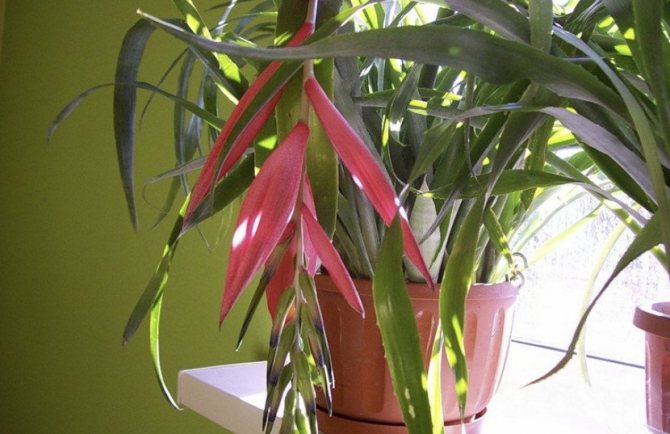
A tropical flower is ideal for a novice grower; it does not require much time and effort to care for. Due to its biological feature (growing on a support), the flower will become an original decoration for home and office interiors. r]
Home care for bilbergia
How to grow bilbergia
Bilbergia easily adapts to almost any conditions, but if you want to see it in its best shape, take the trouble to create conditions close to natural for it.
Bilbergia flower develops equally well both on illuminated windowsills and in the back of the room, therefore it is often used to decorate the interior and create flower arrangements. However, in bright light and in partial shade, it still blooms brighter.
As for the temperature, the plant will be comfortable in the conditions familiar to humans, as long as the room is not cooler than 12 ˚C. But during the flowering period, it is desirable to lower the temperature by 2-3 degrees.
The houseplant Bilbergia is happy to spend the warm season in the open air, therefore, as soon as warm weather sets in and the threat of return frosts has passed, the plant can be arranged in the garden, on the balcony or on the terrace, where it will soon begin to grow young rosettes.The main thing is to protect the indoor bilbergia from drafts, sharp gusts of wind, direct midday rays and precipitation.

Bilbergia develops, replacing faded sockets with newly formed ones, therefore, you need to manually cut off old sockets 4-5 weeks after flowering, so that they do not slow down the development of young promising children.
Watering and feeding bilbergia
The soil in a pot with bilbergia should be kept slightly moist, avoiding stagnation of water in the roots. Between two waterings, the substrate in the pot should dry out to a depth of 2-3 cm.Bilbergia is moistened by the method used for all bromeliads: water at room temperature that has been settled or filtered through a filter should be poured into the center of the leaf funnel.
The difficulty of such watering is that then you need to monitor the water level in the funnel all the time and drain the excess in a timely manner. In addition, if the plant is kept in cool conditions, moistening by this method is excluded, and you cannot pour water into the outlet when the flower is at rest. In these cases, you should simply moisten the soil in the pot.
In winter, when daylight hours are reduced and the temperature of the content decreases, watering of bilbergia is carried out no more than once a week.
Bilbergia at home needs high humidity, so it will be grateful to sprinkle the leaves with cold, settled water, especially when the temperature in the room is above 23 ˚C. During flowering, bilbergia can be placed on a pallet with wet pebbles, wet moss or expanded clay. These measures to increase air humidity are usually sufficient.
Fertilize the substrate in the Bilbergia pot not only during the active growing season, but also during the dormant period, since the plant loves stable conditions. From the beginning of the growing season until the end of flowering, bilbergia is fed twice a month with special mineral complexes for bromeliads. During the dormant period, it is enough to apply top dressing once every 5-6 weeks.
It can be used for feeding bilbergia and fertilizing for flowering indoor plants, however, the concentration of this solution should be two times weaker than indicated in the instructions.
Too much nitrogen in the substrate can cause the death of the epiphyte; therefore, complexes with a standard proportion of elements cannot be used for feeding bilbergia.
Transplant and reproduction of bilbergia
Bilbergia is transplanted as needed, and is combined with the reproduction of the plant by daughter rosettes: the active growth of the flower requires regular planting of the children. As soon as the young rosettes become too crowded in the pot, and the roots of the bilbergia begin to crawl out of the drainage holes, you need to separate the children from the mother plant and plant them. They do this from March to August.
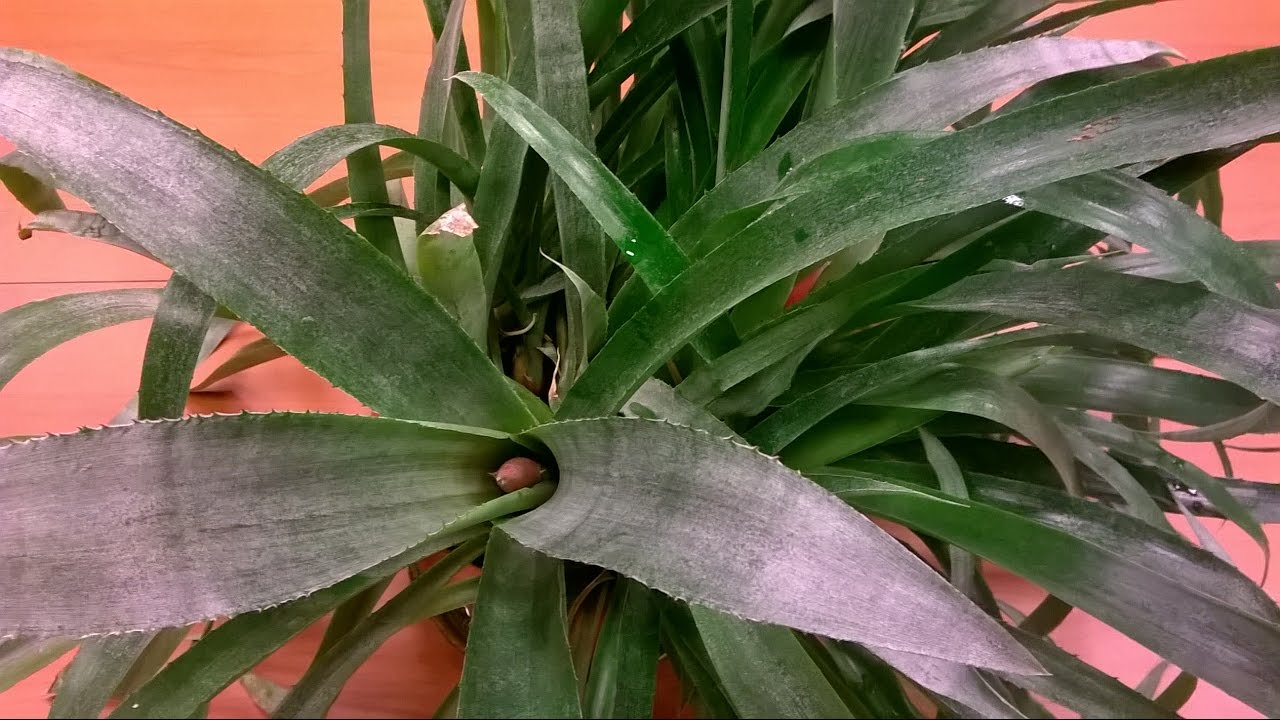
Containers for bilbergia should be chosen larger, since the plant is actively growing: the pots should be not so much deep as wide. A new pot is taken 2-3 cm in diameter larger than the old one. Bilbergia substrate requires a rather specific composition: with a coarse texture, containing only a small amount of sod land and having a pH close to 5.0 pH. Bilbergia grows well in a mixture of equal parts of leafy soil, moss, humus and high peat.
When transplanting, it is not necessary to completely clear the roots of the plant from the old substrate. Just examine them, and if they look healthy, transplant the plant into a new pot, filling the remaining space with fresh substrate. If there are rotten areas on the roots, first cut them out with a sharp, sterile instrument, treat the sections with charcoal powder, and only then plant the flower in a new dish.
How to care for room billberg
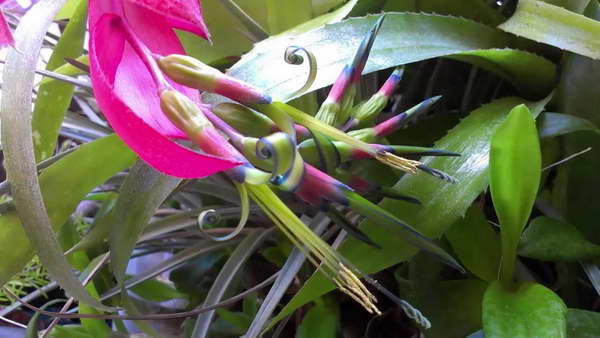
Bilbergia flower photo
Air temperature humidity and lighting
Compared with other plants of the Bromeliad family, bilbergia is less whimsical in care.She perceives dry air more easily, is able to withstand an air temperature of + 2-3 ° C, small drafts will not destroy her, but still you should not abuse it. Grows well in greenhouses, terrariums.
Lighting must be bright, diffused. On southern windows, shade from direct sunlight at noon - just cover the window with translucent paper. May not bloom when placed on a north window. The best place would be west and east facing windows.
For the whole summer, it can be placed outdoors, protected from direct sunlight or precipitation.
The optimum air temperature in the summer season is in the range of 20-28 ° С. By autumn, lower it to 18 ° C. During the dormant period (October-February), the air temperature of about 15-17 ° C is desirable for forms with green leaves, 17-18 ° C for variegated plants. Cool wintering stimulates flowering.
Watering and spraying
In summer, moisturize the substrate regularly, avoid waterlogging. You can use bottom irrigation or pour water into leaf funnels, but the air temperature should be above 20 ° C, and the water should not stagnate. Prolonged stagnation of water in combination with a low air temperature leads to decay or even death of the plant.
With the epiphytic method of cultivation (placement on a bromeliad tree), once every 10 days, the plant should be removed from the support and immersed in settled water for saturation. Allow excess water to drain, then return the bilbergia to its place.
In autumn and winter, when the air temperature is below 20 ° C, water moderately, allowing the top layer of the soil to dry out. If the air temperature is above 20 ° C, you can occasionally pour a small amount of warm water into the leaf funnel.
Bilbergia is capable of carrying dry air, but it is better to keep the air humidity high. Spray a couple of times a day, periodically place on a pallet with damp expanded clay, moss, pebbles. It is better not to spray during the flowering period - drops of water falling on the inflorescences may remain spots.
Top dressing
During the period of active growth, apply special fertilizers designed for Bromeliad or fertilizer for decorative flowering indoor plants in half concentration. Avoid excess nitrogen.
Transfer
Flowering species need to be replanted annually after flowering, the rest as needed.
Grows well in hydroponics. Best grown in a special bromeliad medium. A suitable soil mixture will be: mix in equal proportions turf, leaf, humus soil, peat, add a little sand. You can mix chopped moss, leafy soil, peat, sand in a ratio of 2: 2: 1: 1.
Use a pot that is wide, but not deep. After planting, water moderately for 2-3 weeks and postpone fertilization.
Diseases and pests of bilbergia
The plant is susceptible to infection with fungal diseases. They usually appear in the autumn-winter period when the flower is in a cool room with high humidity and a lack of light. The main signs of damage are:
- general wilting;
- deformation of parts;
- slowdown in growth and development;
- the appearance of brown spots;
- dying off of leaves.
It is not always possible to cure a plant.
Therefore, it is important to prevent stagnation of moisture in the soil and hypothermia of the bush. It is also advisable to use fungicides for preventive treatments once a month.

When growing bilbergia, you can also encounter thrips, mealybugs, spider mites and aphids. To prevent this from happening, it is recommended to follow the rules for keeping the plant and, as a preventive measure, conduct weekly leaf inspections for infection.
It is possible to determine that harmful insects have settled on a flower by the appearance of:
- stains;
- cobwebs;
- holes;
- a sticky or grayish white discharge;
- dark points.
To combat parasites, you should use a soap solution and special means - insecticides.
Other problems:
- sockets do not keep their shape - insufficient illumination;
- the dying off of the rosette is a natural process after flowering or a consequence of waterlogging of the substrate;
- the appearance of brown spots on the leaves - sunburn;
- drying of the tips of the leaf plates - stagnant liquid in the funnel or the use of hard water for irrigation.
Bilbergia is able to bring the owner not only aesthetic pleasure, but also benefit. It emits special volatile substances that have a phytoncidal effect - they destroy harmful microorganisms. Also, the plant helps to absorb loud sounds and create the right energy in the room.
Home care for bilbergia (with photo)
Of all bromeliads, bilbergias are the most unpretentious. They do not require high air humidity, they are not afraid of drafts. Perfect for beginner gardeners.
Bilbergia develops well in terrariums, in warm greenhouses. The plant is very beautiful and can adequately decorate a room, a large hall, a winter garden.
The plant can also be planted in the garden, but in a place protected from wind and sun. Under optimal climatic conditions, it is used for outdoor landscaping.
See how the care of bilbergia is carried out in the photo, which shows the basic operations for transplantation and reproduction:

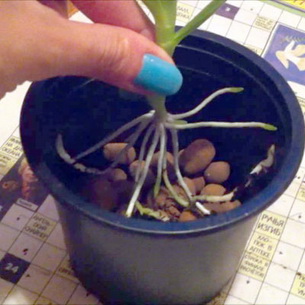
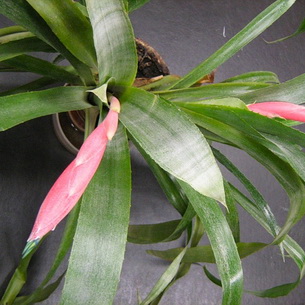
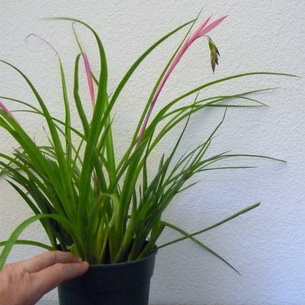
Watering. Humidity is maintained moderate and higher, spraying is mandatory. Watering is sufficient, moderate in autumn. Like most bromeliads, bilbergia is watered directly into an outlet, but only if the air temperature is above 20 ° C; at lower temperatures, only the soil in the pots is moistened. For watering, you must use well-settled tap water at room temperature.
Temperature. Winter minimum 13 ° C. At lower temperatures (but above 0 ° C) it will not die, but it will grow or bloom worse.
Substrate. Can be grown not only in pots, but also on driftwood and bark blocks. In order to transplant or grow a young plant, it is recommended to use a soil mixture that consists of equal parts of leafy soil, pre-crushed pine bark, peat and dry cow dung with the addition of finely crushed charcoal and granular perlite.
Top dressing. Top dressing in the summer is carried out with a solution of mineral or organic fertilizers after two weeks (best of all with a liquid fertilizer containing organic matter).
Bloom. The first flowering can be expected in about three years. Some time after flowering, the rosette dies off and a new plant grows from a creeping stem or rhizome, which blooms in the next season. Older plants develop many narrow-funnel-shaped rosettes, which often bloom at the same time. It is recommended to cut the old rosettes 1-2 months after flowering.
Reproduction. Offshoots that appear around the old faded rosette. Separate them from the parent plant when they are halfway up. It is recommended to sprinkle the cut points with powdered charcoal.
Caring for bilbergia at home in the photo illustrates all the basic agricultural techniques from planting to fertilization:
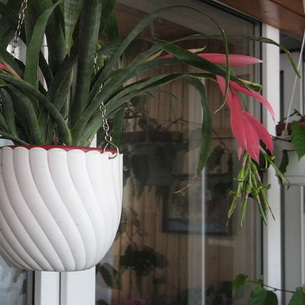
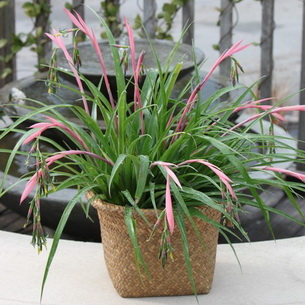

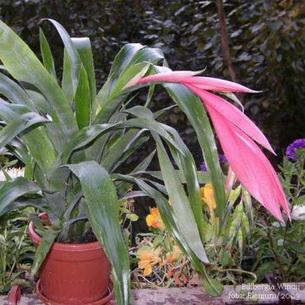
Reproduction is possible by seeds, which are sown on clean sphagnum.
Pests and diseases. Spider mites and scale insects do great harm to the plant. With improper care, spotting appears on bilbergia.
Bilbergia: home care
Temperature
Bilbergia prefers moderate temperatures; in summer, the optimum is 22-25 ° С.
Poorly tolerates dryness and heat above 28 ° C. In winter it is cooler, about 18-20 ° С, minimum + 13 ° С. Do not place bromeliads in a draft, such as near an air conditioner.
Lighting
In bright, diffused light, bilbergia needs some direct sun in the morning or evening. Grows well on east and north windows.It may be too dark on the north window sill, on the south window it is necessary to shade from 11 to 15 o'clock in the form of a light tulle.
Watering
Not all bilbergia have a well-defined rosette of leaves, so they can be watered directly into the soil, like ordinary houseplants - in spring and summer it is quite abundant, after the top layer of the earth dries up. In winter, water is limited or moderate, depending on the temperature, after the soil is almost completely dry in the pot.
Fertilizer
Fertilizing is carried out in spring and summer. For top dressing, special fertilizers are used for bromeliads. You can use half dose fertilizer for other flowering houseplants, or orchid fertilizer (at the recommended dose). Top dressing is carried out after 2 weeks.
Air humidity
Bilbergia needs to be sprayed periodically, the optimum air humidity is 60%. Protect the plant from the dry hot air of the batteries in winter.
Transfer
Annually after flowering into soil, consisting of 1 part of light garden soil, 2 parts of peat or leaf, 1 part of humus, 1 part of vermiculite, sand or pine bark. You can use a commercial bromeliad potting mix. The planting container should not be too deep, it is better to use wide bowls. A high drainage should be poured at the bottom of the pot. As a baking powder, you can use coconut fiber or coconut flakes, as well as a wine cork broken into small pieces (up to 3-5 mm).

